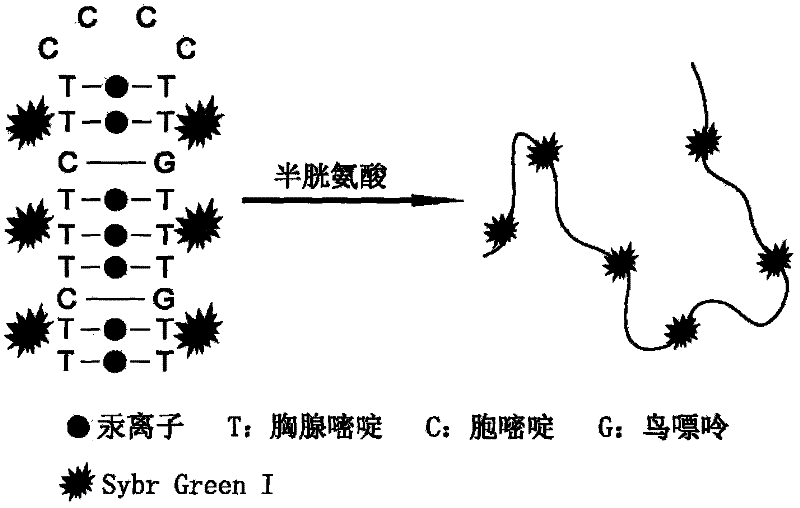Fluorescence detection method of cysteine
A technology for fluorescence detection and cysteine, which is applied in the field of fluorescence detection of cysteine, can solve complex and high-cost problems, achieve high sensitivity and specificity, save detection costs, and simplify operation steps
- Summary
- Abstract
- Description
- Claims
- Application Information
AI Technical Summary
Problems solved by technology
Method used
Image
Examples
Embodiment 1
[0036] Add 2mL buffer (10mM MOPS, containing 0.1M NaNO 3 , pH 7.50), add 2 μL Hg 2+ (70 μM) and mercury ion-specific DNA 10 μL (2 μM), mix evenly for 2 minutes, add 5 μL Sybr Green I (25×), mix evenly, and perform fluorescence test after 2 minutes. On this basis, 4 μL (70 μM) of cysteine was added, mixed evenly, and the fluorescence test was performed immediately. At this moment, the final concentration of each substance is: [MSD]=10nM, [Hg 2+ ]=70nM, [Sybr Green I]=1.225×10 -7 M, [cysteine] = 140 nM.
[0037] Fluorescence spectra before and after addition of cysteine figure 2 As shown, where a is the fluorescence spectrum before the addition of cysteine, the fluorescence intensity at the maximum emission wavelength is 116.7, b is the fluorescence spectrum after the addition of cysteine, and the fluorescence intensity at the maximum emission wavelength is 15. Therefore, the present invention can quantitatively detect cysteine.
[0038] Selection of the concentration o...
Embodiment 2
[0043] Add 2mL buffer (10mM MOPS, containing 0.1M NaNO 3 , pH 7.50), add 2 μL Hg 2+ (70 μM) and mercury ion-specific DNA 10 μL (2 μM), mix evenly for 2 minutes, add 5 μL Sybr Green I (25×), mix evenly, and perform fluorescence test after 2 minutes. On this basis, different concentrations of cysteine were added, mixed evenly, and the fluorescence test was performed immediately. The result is as Figure 4 As shown, it shows that the present invention can quantitatively detect different concentrations of cysteine, and the concentration of cysteine at 7-84nM is directly proportional to the fluorescence intensity.
Embodiment 3
[0045] Replace cysteine with other amino acids and repeat the steps of Example 1, the results are as follows Figure 5 shown. It shows that the present invention is not interfered by other amino acids and has good selectivity.
PUM
 Login to View More
Login to View More Abstract
Description
Claims
Application Information
 Login to View More
Login to View More - R&D
- Intellectual Property
- Life Sciences
- Materials
- Tech Scout
- Unparalleled Data Quality
- Higher Quality Content
- 60% Fewer Hallucinations
Browse by: Latest US Patents, China's latest patents, Technical Efficacy Thesaurus, Application Domain, Technology Topic, Popular Technical Reports.
© 2025 PatSnap. All rights reserved.Legal|Privacy policy|Modern Slavery Act Transparency Statement|Sitemap|About US| Contact US: help@patsnap.com



